
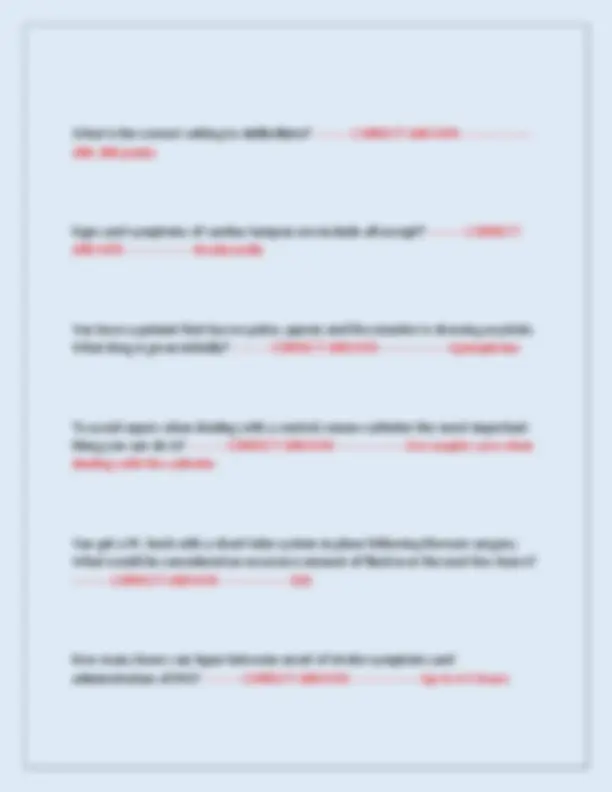
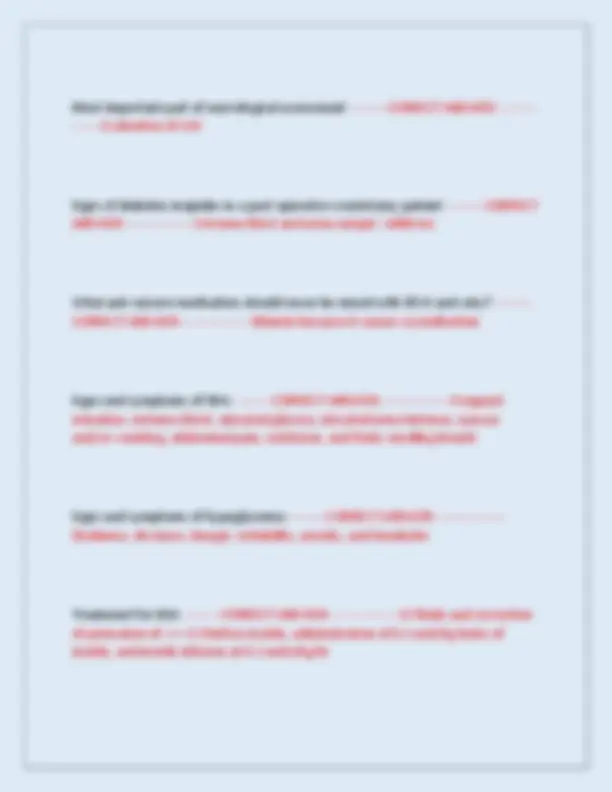
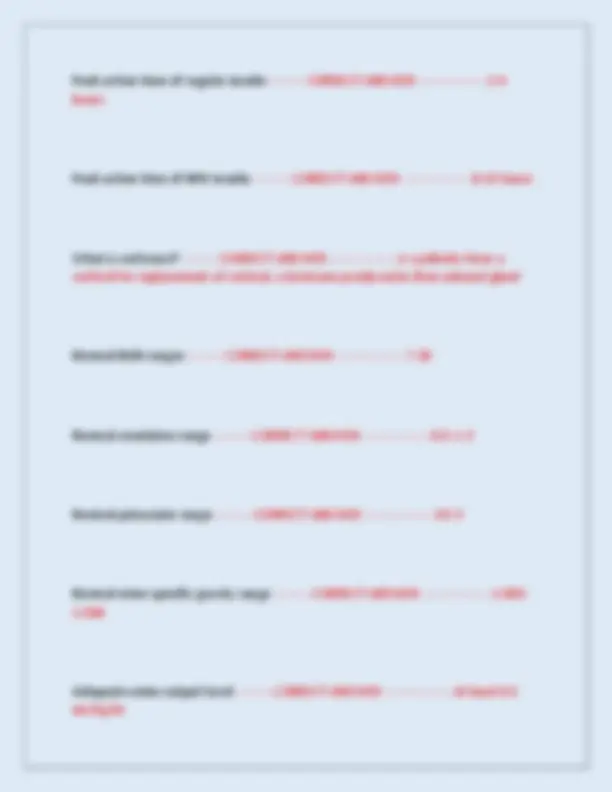
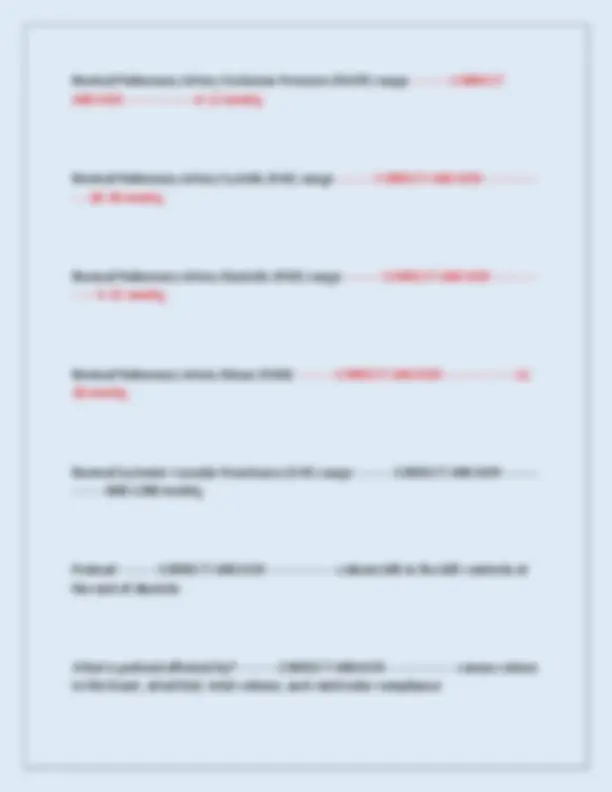
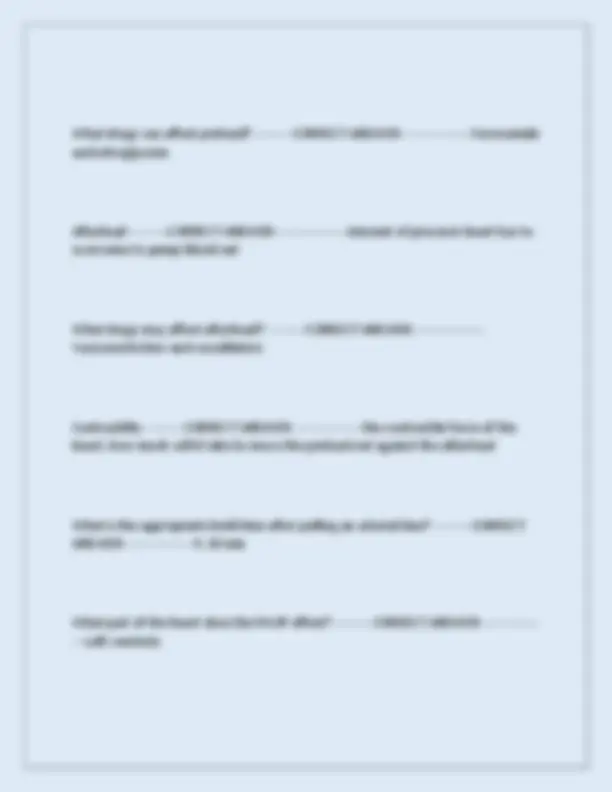
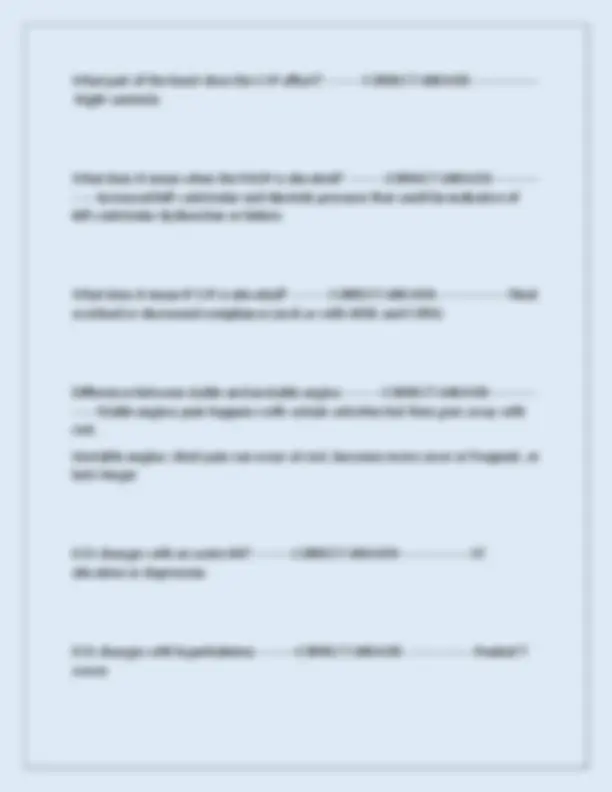
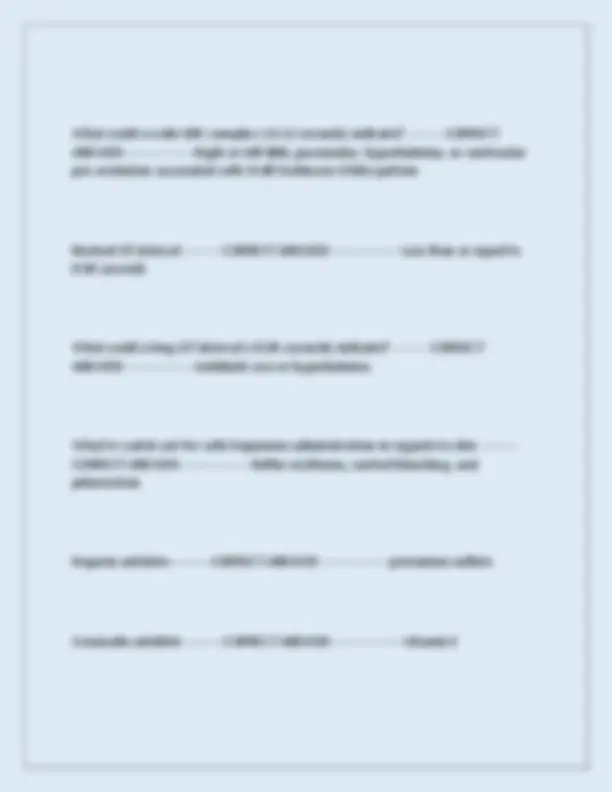
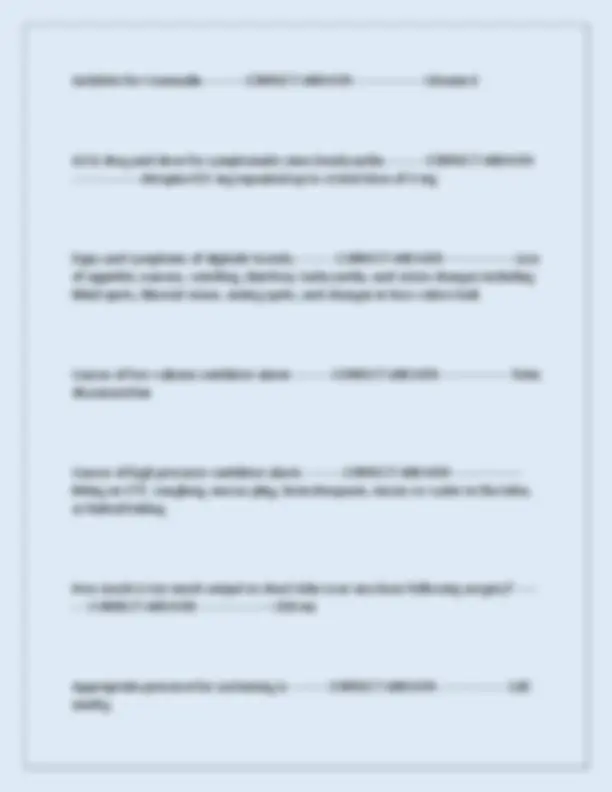
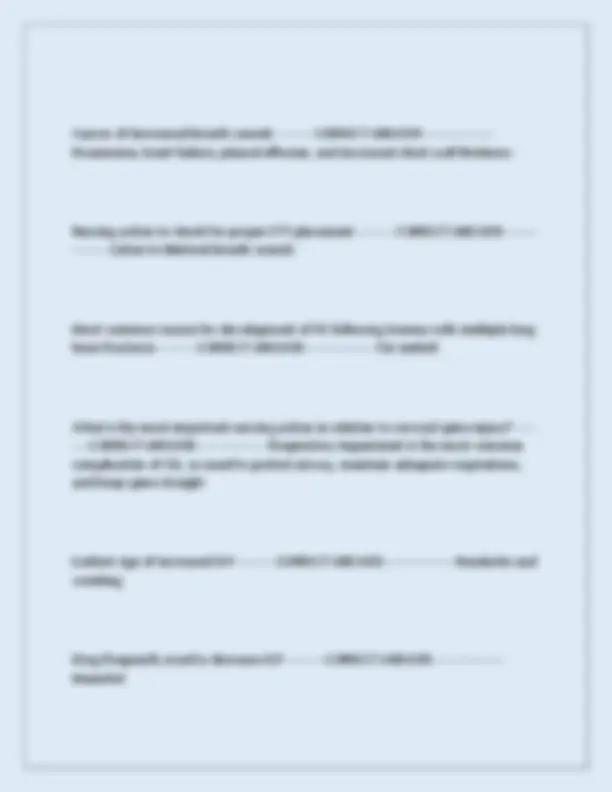
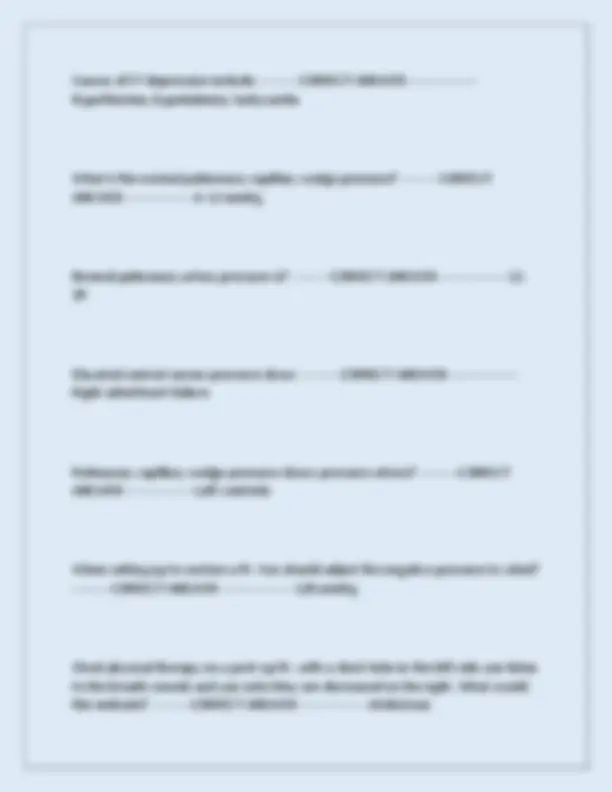
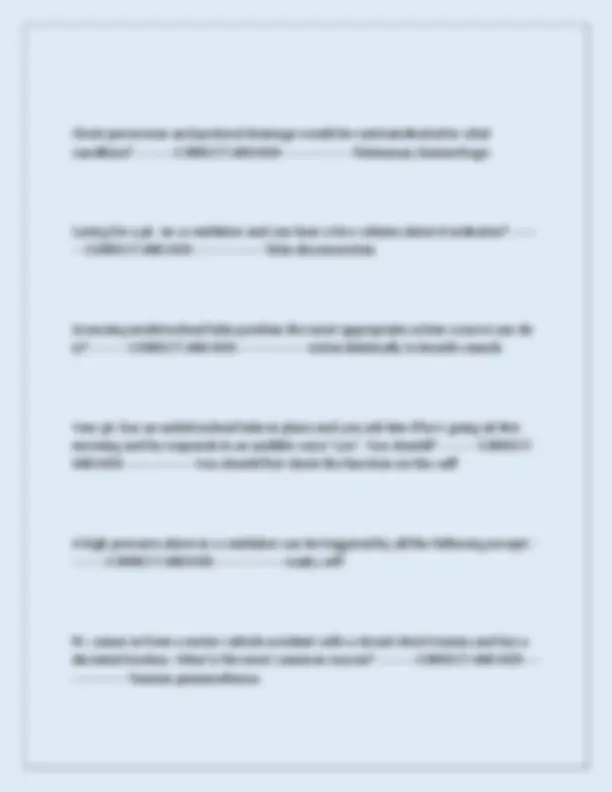
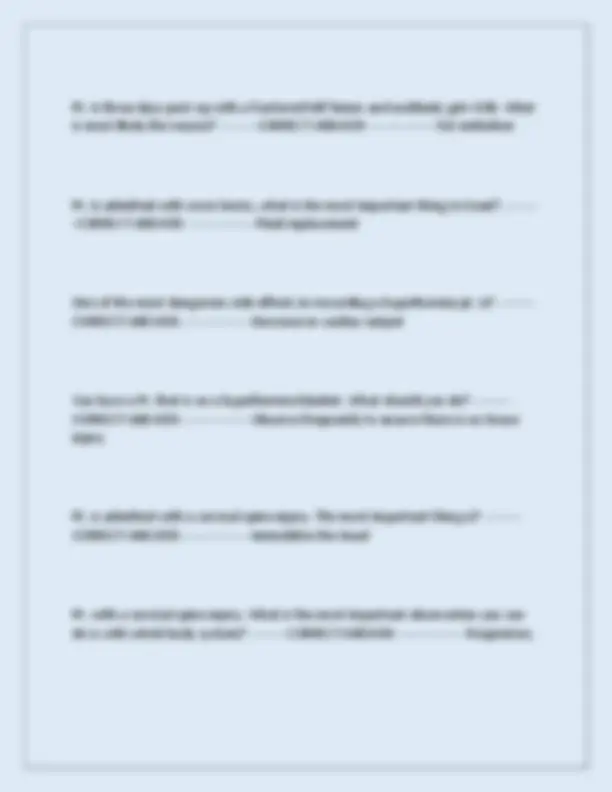
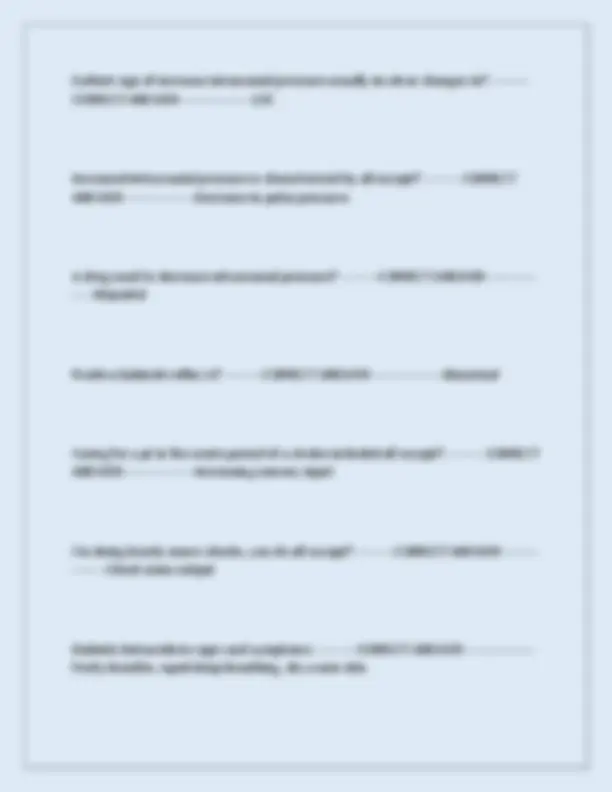
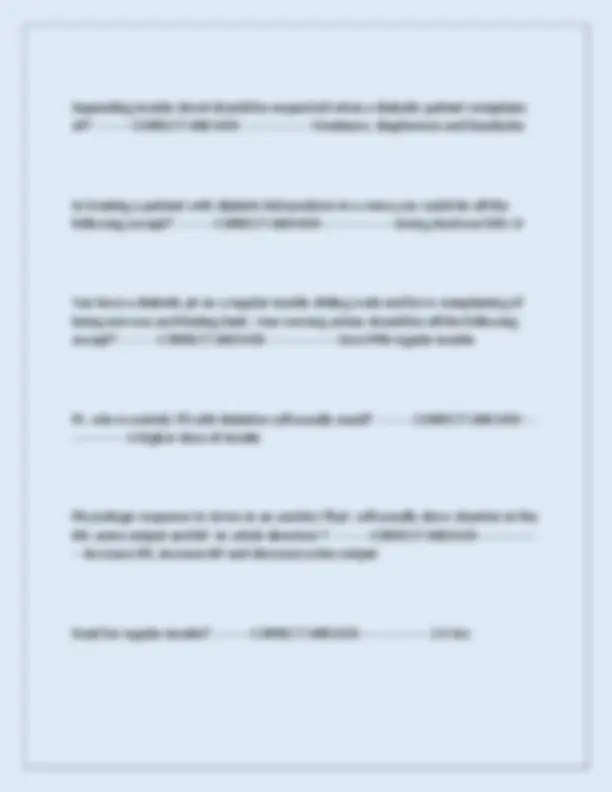
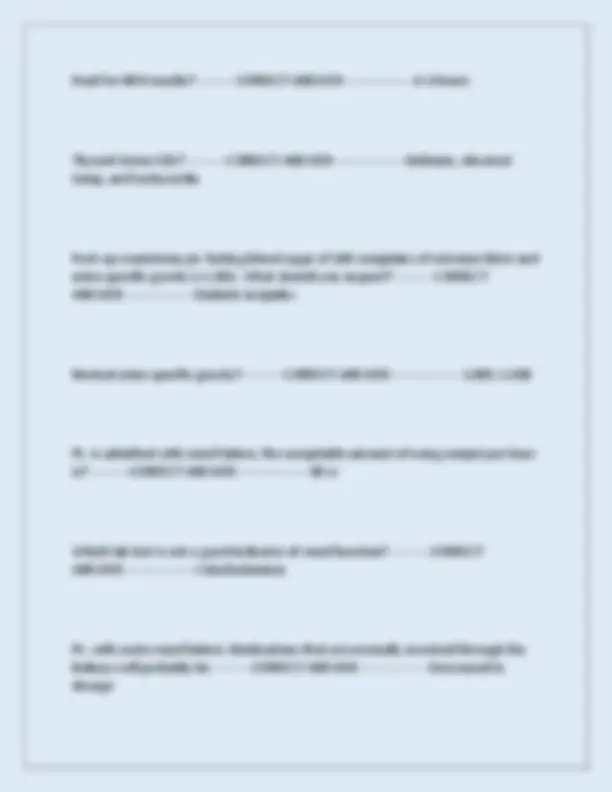
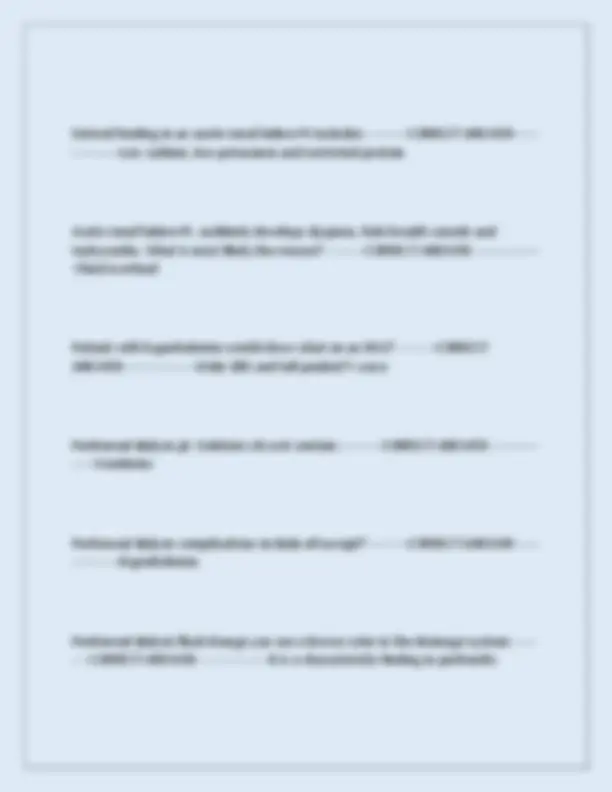
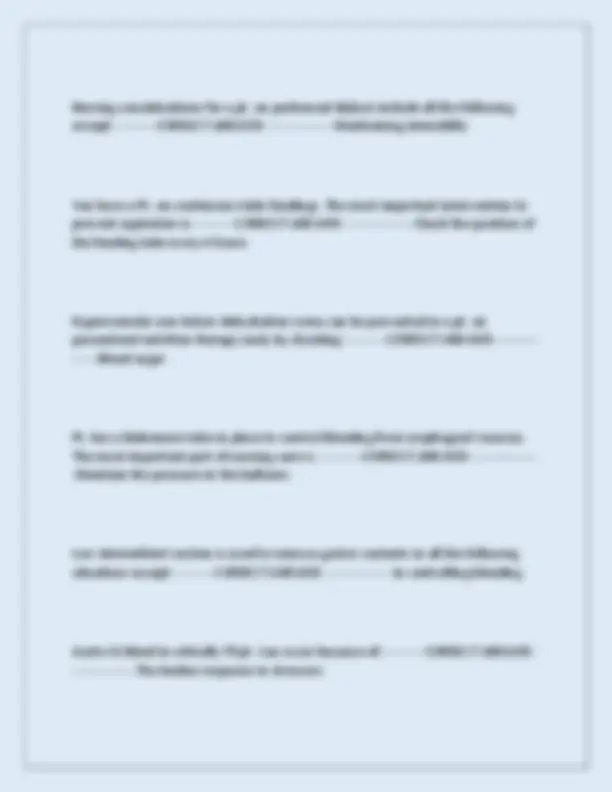
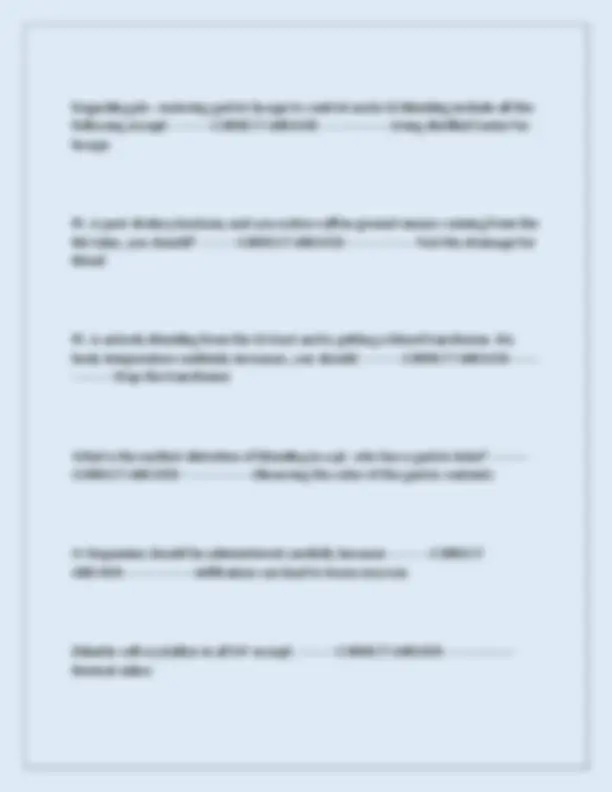
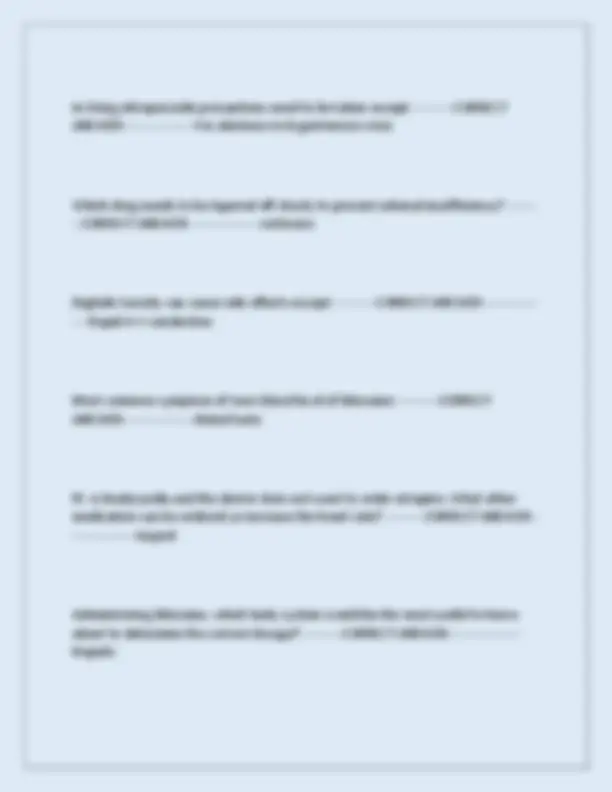
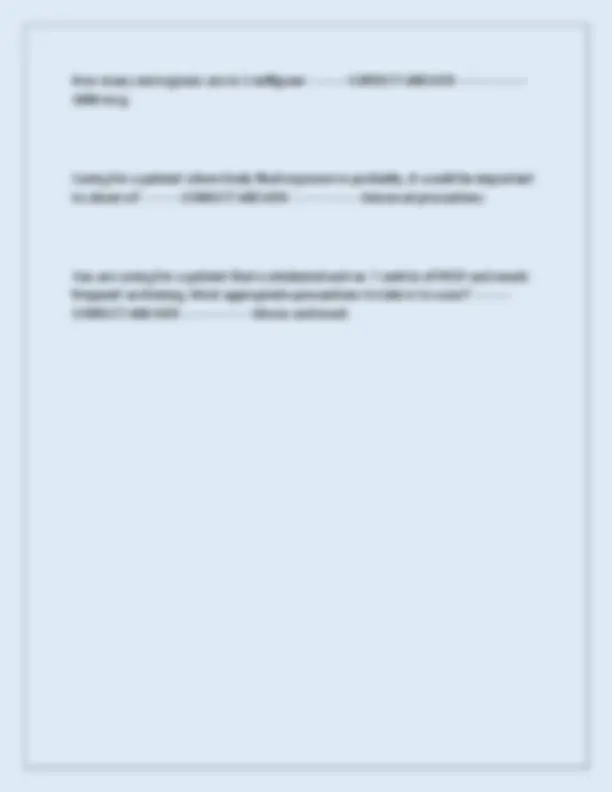


Study with the several resources on Docsity

Earn points by helping other students or get them with a premium plan


Prepare for your exams
Study with the several resources on Docsity

Earn points to download
Earn points by helping other students or get them with a premium plan
Community
Ask the community for help and clear up your study doubts
Discover the best universities in your country according to Docsity users
Free resources
Download our free guides on studying techniques, anxiety management strategies, and thesis advice from Docsity tutors
The BKAT Critical Care Exam 2025 PDF is an essential resource for students and professionals preparing for critical care examinations. This comprehensive guide provides a thorough overview of critical care concepts with a focus on practical applications in clinical settings. The document covers key topics such as pulmonary capillary wedge pressure, cardiac cycle analysis, and renal failure management, offering verified answers to common questions. One of the highlights of this resource is its detailed examination of cardiovascular health, including understanding cardiac waveforms like the P-Wave and QRS Complex, and the implications of their intervals. It also addresses the identification and management of conditions such as left ventricular failure, bundle branch block, and myocardial infarction (MI), providing insights into EKG changes like ST segment elevation.
Typology: Exams
1 / 28

This page cannot be seen from the preview
Don't miss anything!





















Monitor is showing the correct pattern for a pulmonary capillary wedge pressure, you can do all of the following except? ---------CORRECT ANSWER----------------- Flush the line If the pulmonary capillary wedge pressure is elevated it can be an indication of? -- -------CORRECT ANSWER-----------------Left ventricular failure The wave in the cardiac cycle that shows atrial depolarization is? ---------CORRECT ANSWER-----------------P-Wave P-R interval ---------CORRECT ANSWER-----------------0.12-0.20 seconds QRS Complex longer that 0.12 may indicate? ---------CORRECT ANSWER--------------- --Bundle branch block
What is the purpose of enclosing a pacemaker generator in a rubber glove is? ----- ----CORRECT ANSWER-----------------To prevent electrical interference with the pacemaker In which part of the cardiac cycle would a strong ventricular stimulus be dangerous ---------CORRECT ANSWER-----------------T-wave What is the initial drug Tx for ventricular tachycardia? ---------CORRECT ANSWER--- --------------Lidocaine 50-100MG Why is A-Flutter so dangerous? ---------CORRECT ANSWER-----------------It can cause the ventricular rate to increase Is the nurse sees V-Fib they should first ---------CORRECT ANSWER----------------- Establish unresponsiveness A drug that can be given in complete heart block is? ---------CORRECT ANSWER----- ------------Atropine A Pt. Has atrial flutter with a ventricular response into the 150's what could be done? ---------CORRECT ANSWER-----------------Cardioversion, verapamil or digoxin
Most important part of neurological assessment ---------CORRECT ANSWER---------- -------Evaluation of LOC Signs of diabetes insipidus in a post operative craniotomy patient ---------CORRECT ANSWER-----------------Extreme thirst and urine output >1000 mL What anti-seizure medication should never be mixed with D5W and why? --------- CORRECT ANSWER-----------------Dilantin because it causes crystallization Signs and symptoms of DKA ---------CORRECT ANSWER-----------------Frequent urination, extreme thirst, elevated glucose, elevated urine ketones, nausea and/or vomiting, abdominal pain, confusion, and fruity-smelling breath Signs and symptoms of hypoglycemia ---------CORRECT ANSWER----------------- Shakiness, dizziness, hunger, irritability, anxiety, and headache Treatment for DKA ---------CORRECT ANSWER-----------------IV fluids and correction of potassium of </= 3.3 before insulin, administration of 0.1 unit/kg bolus of insulin, and insulin infusion at 0.1 units/kg/hr
Peak action time of regular insulin ---------CORRECT ANSWER----------------- 2 - 4 hours Peak action time of NPH insulin ---------CORRECT ANSWER----------------- 8 - 14 hours What is cortisone? ---------CORRECT ANSWER-----------------A synthetic form a cortisol for replacement of cortisol, a hormone produced in then adrenal gland Normal BUN ranges ---------CORRECT ANSWER----------------- 7 - 20 Normal creatinine range ---------CORRECT ANSWER-----------------0.5-1. Normal potassium range ---------CORRECT ANSWER-----------------3.5- 5 Normal urine specific gravity range ---------CORRECT ANSWER-----------------1.003-
Adequate urine output level ---------CORRECT ANSWER-----------------At least 0. mL/kg/hr
Signs and symptoms of blood transfusion reactions ---------CORRECT ANSWER------ -----------Back pain, dark urine, chills, fainting, dizziness, fever, flank pain, skin flushing, and shortness of breath Most important treatment in burn patients with 24 hours following airway securment ---------CORRECT ANSWER-----------------IV fluid resuscitation Why should a hypothermic patient not be rapidly re-warmed? ---------CORRECT ANSWER-----------------Rebound increased ICP True or false: A medical power of attorney gives the person the right to make all medical decisions for the patient while in critical care? ---------CORRECT ANSWER-- ---------------False ACLS rhythms that amiodarone is used to treat ---------CORRECT ANSWER------------ -----V-fib and pulseless v-tach Normal Central Venous Pressure (CVP) range ---------CORRECT ANSWER--------------- -- 2 - 8 mmHg
Normal Pulmonary Artery Occlusion Pressure (PAOP) range ---------CORRECT ANSWER----------------- 6 - 12 mmHg Normal Pulmonary Artery Systolic (PAS) range ---------CORRECT ANSWER------------- ---- 20 - 30 mmHg Normal Pulmonary Artery Diastolic (PAD) range ---------CORRECT ANSWER----------- ------ 5 - 15 mmHg Normal Pulmonary Artery Mean (PAM) ---------CORRECT ANSWER----------------- 11 - 20 mmHg Normal Systemic Vascular Resistance (SVR) range ---------CORRECT ANSWER--------- -------- 800 - 1200 mmHg Preload ---------CORRECT ANSWER-----------------volume left in the left ventricle at the end of diastole What is preload affected by? ---------CORRECT ANSWER-----------------venous return to the heart, atrial kick, total volume, and ventricular compliance
What part of the heart does the CVP affect? ---------CORRECT ANSWER----------------
What conditions may cause elevated cardiac enzymes? ---------CORRECT ANSWER- ----------------Trauma, acute MI, CABG, and pericarditis What is the goal of treatment with cariogenic shock? ---------CORRECT ANSWER---- -------------to increase cardiac output What are the effects of nitroprusside (Nipride) and dobutamine (Dobutrex) on preload, afterload, and contractility? ---------CORRECT ANSWER-----------------They both increase cardiac output, heart rate, and contractility Special precautions of Nipride ---------CORRECT ANSWER-----------------It can cause severe hypotension and cyanide toxicity Where to listen to assess with a murmur associated with aortic stenosis --------- CORRECT ANSWER-----------------right upper sternal border What is the most important thing to watch for when administering tPa? --------- CORRECT ANSWER-----------------mental status changes
What could a wide QRS complex (>0.12 seconds) indicate? ---------CORRECT ANSWER-----------------Right or left BBB, pacemaker, hyperkalemia, or ventricular pre-excitation associated with Wolf-Parkinson-White pattern Normal QT interval ---------CORRECT ANSWER-----------------Less than or equal to 0.04 seconds What could a long QT interval (>0.04 seconds) indicate? ---------CORRECT ANSWER-----------------Antibiotic use or hyperkalemia What to watch out for with Dopamine administration in regards to skin --------- CORRECT ANSWER-----------------Reflex erythema, central blanching, and piloerection Heparin antidote ---------CORRECT ANSWER-----------------protamine sulfate Coumadin antidote ---------CORRECT ANSWER-----------------Vitamin K
Antidote for Coumadin ---------CORRECT ANSWER-----------------Vitamin K ACLS drug and dose for symptomatic sinus bradycardia ---------CORRECT ANSWER- ----------------Atropine 0.5 mg repeated up to a total dose of 3 mg Signs and symptoms of digitalis toxicity ---------CORRECT ANSWER-----------------Loss of appetite, nausea, vomiting, diarrhea, tachycardia, and vision changes including blind spots, blurred vision, seeing spots, and changes in how colors look Causes of low volume ventilator alarm ---------CORRECT ANSWER-----------------Tube disconnection Causes of high pressure ventilator alarm ---------CORRECT ANSWER----------------- Biting on ETT, coughing, mucus plug, bronchospasm, mucus or water in the tube, or kinked tubing How much is too much output in chest tube over one hour following surgery? ----- ----CORRECT ANSWER----------------->150 mL Appropriate pressure for suctioning is ---------CORRECT ANSWER----------------- 120 mmHg
Amiodarone dosage for ACLS ---------CORRECT ANSWER-----------------300 mg Signs and symptoms of cyanide toxicity ---------CORRECT ANSWER----------------- Mental status changes, tachycardia, seizure, a need for an increase in dose, and unexplained metabolic acidosis Initial Measures For TX of Angina ---------CORRECT ANSWER----------------- Morphine, oxygen, nitrogen, aspirin Pt. Is depressed in the first few days after having an MI, most appropriate nursing action is: ---------CORRECT ANSWER-----------------Encourage the Pt. to ventilate feelings and concerns Pt. Is a couple days post MI and is getting out of bed for the first time and his HR increases from 80's to 90's. The nurse should do what? ---------CORRECT ANSWER- ----------------Check his VS Major therapeutic goal in the Tx of cardiogenic shock is? ---------CORRECT ANSWER-----------------Increase the cardiac output
Elevated cardiac enzymes occur in all of the following EXCEPT: ---------CORRECT ANSWER-----------------CHF *will occur in trauma, CABG, and pericarditis What is the classic EKG change in a MI: ---------CORRECT ANSWER-----------------ST segment elevation After an arterial catheter is removed direst pressure should be applied for how long? ---------CORRECT ANSWER----------------- 5 - 10 minutes A CVP reading directly measures pressure where? ---------CORRECT ANSWER-------- ---------Right Atrium You can use an arterial line for all the following except: ---------CORRECT ANSWER- ----------------Administration of drugs Causes of ST elevation include: ---------CORRECT ANSWER-----------------MI, pericarditis, left bundle branch block, left ventricular hypertrophy, hyperkalemia
Chest percussion and postural drainage would be contraindicated in what condition? ---------CORRECT ANSWER-----------------Pulmonary hemorrhage Caring for a pt. on a ventilator and you hear a low volume alarm it indicates? ------ ---CORRECT ANSWER-----------------Tube disconnection Assessing endotracheal tube position the most appropriate action a nurse can do is? ---------CORRECT ANSWER-----------------Listen bilaterally to breath sounds Your pt. has an endotracheal tube in place and you ask him if he's going ok this morning and he responds in an audible voice "yes". You should? ---------CORRECT ANSWER-----------------You should first check the function on the cuff A high pressure alarm in a ventilator can be triggered by all the following except: - --------CORRECT ANSWER-----------------Leaky cuff Pt. comes in from a motor vehicle accident with a closed chest trauma and has a deviated trachea. What is the most common reason? ---------CORRECT ANSWER---- -------------Tension pneumothorax
Pt. Is three days post-op with a fractured left femur and suddenly gets SOB. What is most likely the reason? ---------CORRECT ANSWER-----------------Fat embolism Pt. Is admitted with sever burns, what is the most important thing to treat? --------